2025, Cyberculture
Time Spent on Authentication: Detailed and Analytical Overview
In-Depth Analysis of Authentication Time Across Methods
Time Spent on Authentication is critical to digital security. This study explores manual methods, password managers, and tools like PassCypher NFC HSM or PassCypher HSM PGP, analyzing their efficiency, security, and impact. It highlights economic, environmental, and behavioral implications, emphasizing the role of advanced technologies in shaping faster, secure, and sustainable authentication practices globally.
Study Overview: Objectives and Scope
Understanding the cost of authentication time is crucial to improving productivity and adopting advanced authentication solutions.
This study examines the time spent on authentication across various methods, highlighting productivity impacts and exploring advanced tools such as PassCypher NFC HSM or PassCypher HSM PGP for secure and efficient login processes. It provides insights into manual and automated methods and their global adoption.
Objective of the Study
- Quantify the time required to log in with pre-existing credentials stored on physical or digital media, with or without MFA.
- Evaluate all authentication methods, including manual logins, digital tools, and advanced hardware solutions such as PassCypher NFC HSM or PassCypher HSM PGP.
- Compare professional and personal contexts to highlight global productivity impacts
Authentication Methods Analyzed
Manual Methods
- Paper-based storage: Users read passwords from paper and manually enter them.
- Memorized credentials: Users rely on memory for manual entry.
Digital Manual Methods
- File-based storage: Credentials stored in text files, spreadsheets, or notes, used via copy-paste.
- Browser-based managers (no MFA): Autofill tools integrated into browsers.
Password Managers
- Basic password manager (no MFA): Software tools enabling autofill without additional security.
- Password manager (with MFA): Software requiring a master password and multi-factor authentication.
Hardware-Based Authentication
- Non-NFC hardware managers: Devices requiring physical connection and PIN entry.
- NFC-enabled hardware managers: Tools like PassCypher NFC HSM, utilizing contactless authentication.
Modern Authentication Methods
- Passkeys and FIDO: Passwordless solutions using biometrics or hardware tokens.
Time Spent on Password Changes
Corporate Cybersecurity Policies and the Cost of Authentication Time
| Policy | Time Per Change (Minutes) | Frequency (Per Year) |
|---|---|---|
| Monthly Password Changes | 10 | 12 |
| Quarterly Changes | 10 | 4 |
| Ad Hoc Changes (Forgotten) | 15 | 2 |
Time-Intensive Scenarios
Denial of Service (DoS) Impact
Extended login delays during attacks lead to significant downtime:
- Professional Users: 15–30 minutes per incident.
- Personal Users: 10–20 minutes per incident.
Forgotten Passwords
Password recovery processes average 10 minutes but can extend to 30 minutes if additional verification is required.
Regional Comparisons of Credential Use and Time
Credential Usage Across Regions
| Region | Average Personal Credentials | Average Professional Credentials |
| North America | 80 | 120 |
| Europe | 70 | 110 |
| Asia | 50 | 90 |
| Africa | 30 | 50 |
| South America | 40 | 60 |
Regional Credential Usage: A Heatmap Overview
This diagrame present the differences in credential usage across global regions. This heatmap highlights the number of credentials used for personal and professional purposes, revealing regional trends in authentication practices and the adoption of advanced methods.

Cultural and Infrastructural Influences
In Asia, biometric solutions dominate due to advanced mobile ecosystems. North America shows a preference for NFC and password managers, while Africa and South America rely on manual methods due to slower technological adoption.
Behavioral Insights and Frustrations
Behavioral insights provide critical understanding of how users perceive and respond to the cost of authentication time.
Credential Change Frequency
Organizations enforce frequent password changes to meet cybersecurity standards, with monthly resets common in sectors like finance. Ad hoc changes often occur when users forget credentials.
MFA and DoS Impact
Complex MFA processes frustrate users, causing abandonment rates to rise. DoS attacks lead to login delays, resulting in significant productivity losses of up to 30 minutes per incident.
User Impact Analysis: MFA vs DoS Challenges
This mindmap explores the frustrations caused by complex multi-factor authentication (MFA) processes and delays from denial-of-service (DoS) attacks. Learn how these challenges affect user productivity and time spent on authentication.
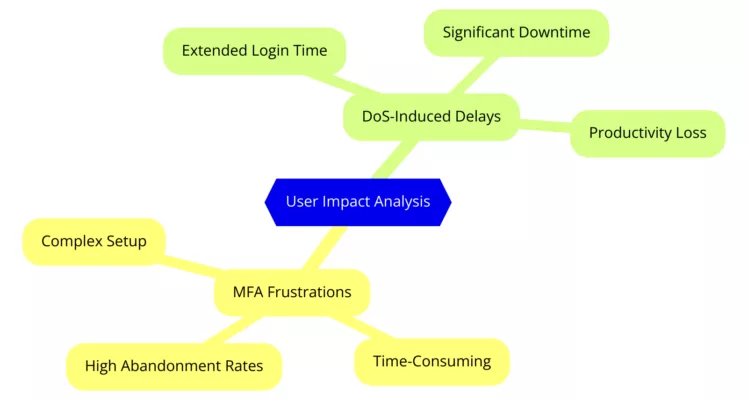
Daily and Annual Time Allocation
Daily Login Frequency
| User Type | Logins/Day |
| Professional Users | 10–15 |
| Personal Users | 5–7 |
| Mixed Use (Both) | 12–18 |
Daily Login Frequency: Comparing User Habits
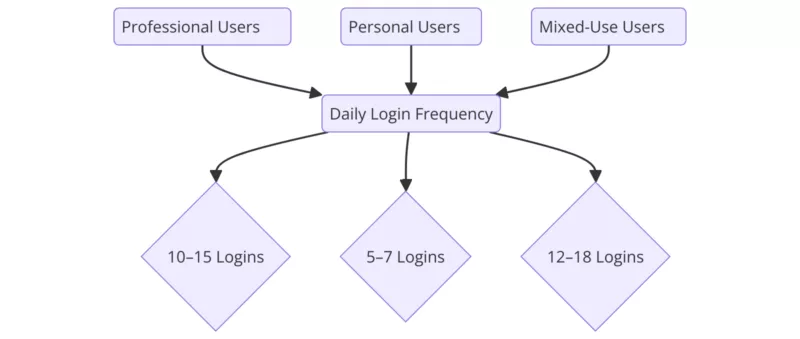
Beyond the time spent on authentication, it’s crucial to consider its financial implications, especially in business or remote work contexts.
Accounting for the Cost of Authentication Time in Professional and Personal Contexts
The cost of authentication time is often underestimated, but when scaled across organizations, these delays translate into significant financial losses.
Overview: Time Is Money
Time spent on authentication, whether in professional, personal, or remote work contexts, often feels insignificant. However, scaled across an organization, these seemingly minor tasks translate into substantial financial losses. This section highlights the cost of time spent identifying oneself, managing passwords, and handling secure devices. We explore daily, monthly, and annual impacts across professional, private, and telework scenarios, demonstrating the transformative value of advanced solutions like PassCypher NFC HSM and PassCypher HSM PGP.
Key Scenarios for Time Allocation
| Scenario | Time Spent (Minutes) | Frequency (Per Day) | Monthly Total (Hours) | Annual Total (Hours) |
|---|---|---|---|---|
| Searching for stored passwords | 5 | 2 | 5 | 60 |
| Manual entry of memorized credentials | 3 | 5 | 7.5 | 90 |
| Copy-pasting from files or managers | 2 | 5 | 5 | 60 |
| Unlocking secure USB devices | 5 | 1 | 2.5 | 30 |
| Recovering forgotten passwords | 15 | 0.5 | 3.75 | 45 |
| Total (Typical Professional User) | 23.75 | 285 |
Financial Costs of Authentication Time
According to a study by Gartner companies dedicate up to 30% of IT tickets to password resets, with an average cost of $70 per request. By integrating solutions like PassCypher, these costs could be halved.
Based on industry reports and wage data from sources such as Gartner and the Bureau of Labor Statistics, the estimated average hourly wage for IT professionals ranges between $30 and $45, depending on experience, location, and sector. Considering a conservative estimate of $30 per hour, the financial impact of time spent on authentication becomes significant:
| User Type | Monthly Cost ($) | Annual Cost ($) |
|---|---|---|
| Single Professional | 712.50 | 8,550 |
| Small Business (50 users) | 35,625 | 427,500 |
| Medium Enterprise (1,000 users) | 712,500 | 8,550,000 |
Common References (2024–2025)
| Geographic Area | Approximate Gross Hourly Wage | Source |
|---|---|---|
| USA (Gartner) | $31.06/h (April 2025) | Trading Economics |
| Eurozone (OECD) | €30.2/h (2022, estimate) | INSEE |
| France (INSEE 2024) | €28.4/h average gross wage | INSEE |
| UK | ~£22/h → ~€26/h (weekly average wage of £716) | Trading Economics |
| Global (IT sector) | Between $30–$45/h depending on level | BDM |
Insight:
For a medium-sized enterprise, authentication time alone can lead to more than $8.5 million per year in lost productivity. This estimate does not include potential financial risks associated with security breaches, human errors, or compliance issues, which could significantly amplify overall costs.
Comparing Traditional and Advanced Authentication Solutions
Traditional authentication methods significantly increase costs due to inefficiencies, whereas advanced authentication solutions like PassCypher NFC HSM and PassCypher HSM PGP streamline processes, enhance security, and reduce expenses.
Traditional Authentication
- Cumulative Costs: High due to time-intensive processes such as searching, memorizing, and manually entering passwords.
- Risk Factors: Frequent errors, delays, and forgotten credentials lead to operational inefficiencies and increased support costs.
Advanced Authentication with PassCypher Solutions
- Cumulative Costs: Significantly reduced with modern authentication tools.
- Auto-Connection with PassCypher NFC HSM: Login times drop to less than 10 seconds, improving efficiency in high-frequency authentication tasks.
- One-Step Login with PassCypher HSM PGP: Even single-step logins are completed in just 1 second, minimizing delays.
- Dual-Stage Login with PassCypher HSM PGP: Two-step logins, including OTP validation, are completed in only 3 seconds, ensuring security without compromising speed.
Cost Reduction Example
A 50% decrease in authentication time for a 1,000-employee enterprise results in $4.25 million in annual savings, demonstrating the financial advantages of streamlined authentication solutions.
Telework and the Cost of Authentication Time
Remote work amplifies the cost of authentication time, with teleworkers spending considerable time accessing multiple systems daily. Advanced authentication solutions mitigate these delays.
Example: Remote Work
- A teleworker accesses 10 different systems daily, spending 30 seconds per login.
- Annual Cost Per Employee:
- Time: ~21 hours (~1,250 minutes).
- Financial: $630 per employee.
Enterprise Impact:
For a company with 1,000 remote workers, telework-related authentication costs can reach $630,000 annually.
Telework Costs and Authentication: Time Spent on Authentication
This diagram provides a detailed view of telework’s financial impacts, highlighting direct, indirect, and productivity-related costs. It emphasizes the significant savings in time spent on authentication achievable with advanced tools like PassCypher, reducing costs and enhancing productivity.
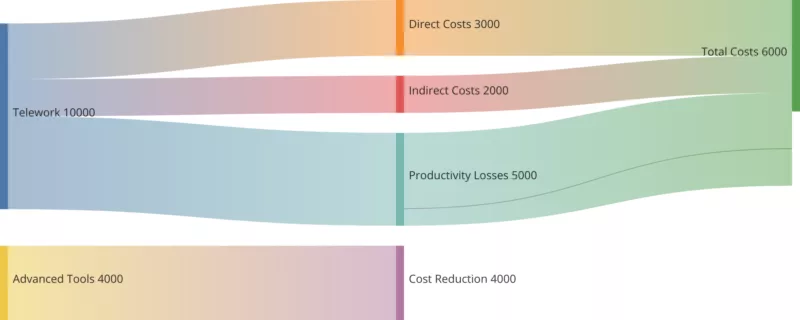
Solutions to Reduce Costs
Adopt Advanced Tools:
- PassCypher NFC HSM: Offers auto-connection on Android NFC devices for login in <10 seconds, streamlining the process and eliminating manual input delays.
- PassCypher HSM PGP: Enables one-click logins in <1 second, reducing dual-stage authentication to just 3 seconds.
- Bluetooth Keyboard Emulator: Enhances NFC HSM devices by enabling universal credential usage across any system supporting USB HID Bluetooth keyboards, reducing login times to under 9 seconds.
Consolidate Authentication:
- Single Sign-On (SSO): Minimize the need for multiple logins across platforms.
Train Employees:
- Efficient password management practices help staff save time and reduce frustration.
Annual Authentication Costs for Businesses
This diagram compares the annual authentication costs for small, medium, and large businesses. It highlights the financial savings achieved with advanced methods like PassCypher NFC HSM, showcasing their cost-effectiveness compared to traditional solutions.

Example of PassCypher NFC HSM in Action
With PassCypher NFC HSM:
- Scenario: A professional logs in 15 times daily.
- Time Saved: Traditional methods take 5 minutes daily (~20 seconds/login); NFC HSM reduces this to 15 seconds daily (~1 second/login).
- Annual Time Saved: ~24 hours/user.
- Financial Savings: $720/user annually; $720,000 for 1,000 users.
This showcases the transformative impact of modern tools in reducing costs and boosting productivity.
Annual Time Spent on Authentication
| Authentication Method | Professional (Hours/Year) | Personal (Hours/Year) |
| Manual (paper-based storage) | 80 | 60 |
| Manual (memorized credentials) | 55 | 37 |
| File-based storage (text, Word, Excel) | 47 | 31 |
| Browser-based managers (no MFA) | 28 | 20 |
| Password manager (basic, no MFA) | 28 | 20 |
| Password manager (with MFA) | 33 | 23 |
| Non-NFC hardware password manager | 37 | 25 |
| NFC-enabled hardware password manager | 27 | 19 |
| PassCypher NFC HSM (Auto-Connection) | 18 | 12 |
| PassCypher NFC HSM (TOTP with MFA) | 24 | 15 |
| PassCypher HSM PGP (Segmented Key) | 7 | 5 |
IT Cost Savings Through Advanced Authentication
Adopting advanced authentication methods can reduce IT costs significantly. This line graph illustrates potential savings over five years, emphasizing the value of transitioning to modern tools like NFC and passwordless solutions.
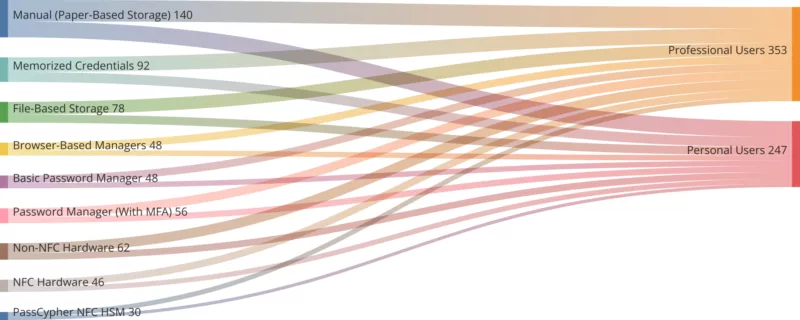
Economic Impact of Advanced Authentication Solutions
This suject highlights the economic implications of authentication practices, focusing on how advanced authentication solutions reduce the cost of authentication time and improve productivity.
IT Cost Reduction
Password resets account for up to 30% of IT tickets, costing $70 each. A 50% reduction could save companies with 1,000 employees $350,000 annually.
Productivity Gains
Switching to advanced methods like Passkeys or NFC saves 50 hours per user annually, translating to 50,000 hours saved for a 1,000-employee company, valued at $1.5 million annually.
Five-Year Cost Savings with Advanced Authentication
This diagram visualizes the financial benefits of adopting advanced authentication solutions. Over five years, companies can achieve significant cost savings, reflecting the economic advantages of modernizing authentication methods.
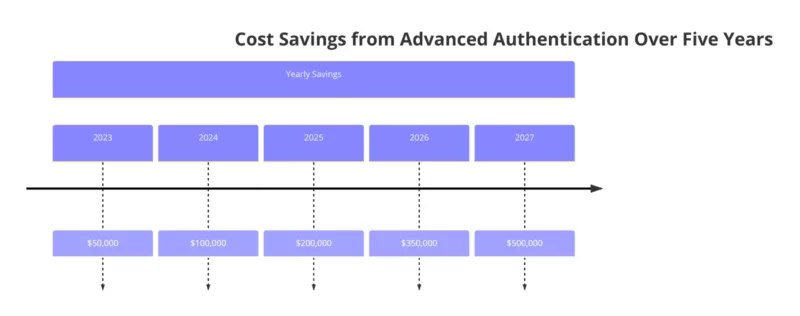
Environmental Impacts
The environmental impact of authentication processes is often underestimated. According to analysis from the Global e-Sustainability Initiative (GeSI), password resets place an additional load on data centers, significantly increasing energy consumption. Optimizing processes with modern tools like PassCypher NFC HSM can reduce this consumption by up to 25%, thereby cutting associated CO2 emissions.
Data Center Energy Costs
Extended authentication processes increase server workloads. Password resets alone involve multiple systems, significantly impacting energy use.
Global Energy Savings
Data centers represent a significant share of CO2 emissions from digital processes. According to the Global e-Sustainability Initiative (GeSI), optimizing authentication processes could reduce their carbon footprint by 10,000 metric tons annually
Energy and Carbon Footprint of Authentication Methods
Explore the environmental impact of authentication processes. This diagram compares energy usage and carbon emissions between traditional and modern methods, showcasing how advanced solutions can lead to a more sustainable future.
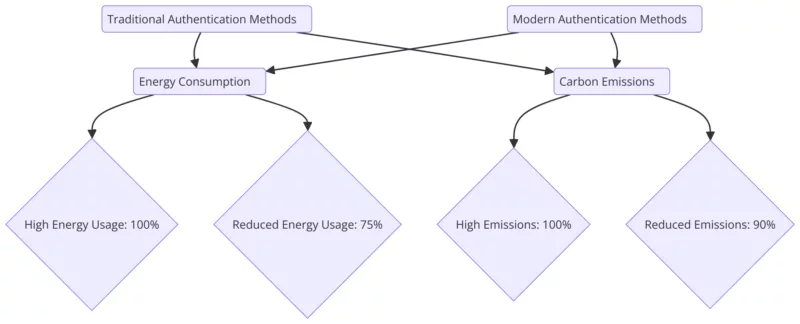
Future Trends in Advanced Authentication Solutions
Emerging technologies and advanced authentication solutions, such as AI-driven tools and passwordless methods, promise to further reduce the cost of authentication time.
Emerging Technologies
AI-driven authentication tools predict user needs and streamline processes. Wearables like smartwatches offer instant, secure login capabilities.
Passwordless Solution Adoption
Passkeys and FIDO technologies are expected to reduce global authentication time by 30% by 2030, marking a shift toward enhanced security and efficiency.
Key Trends in Passwordless Authentication
This diagram provides a detailed timeline of the evolution of passwordless authentication from 2023 to 2030. It outlines major advancements like the adoption of passkeys, the rise of wearable-based and AI-powered authentication, and the significant time savings these methods offer by 2030.
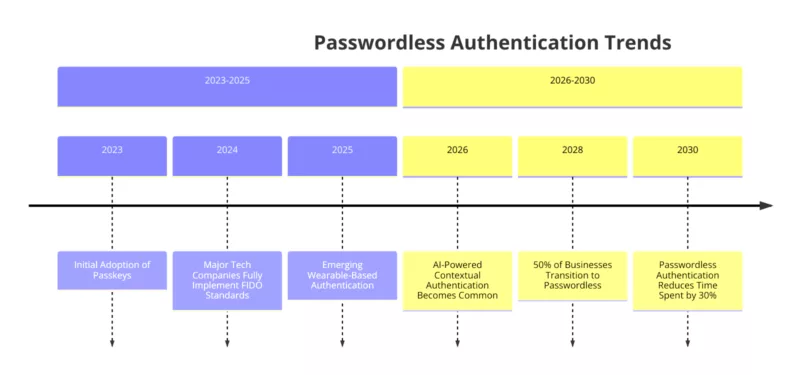
Statistical Insights and Visualizations
Authentication consumes 9 billion hours annually, with inefficient methods costing businesses over $1 million per year in lost productivity. Advanced tools like PassCypher NFC HSM can save users up to 50 hours annually.
Global Insights: Authentication Trends and Productivity
Explore the global trends in authentication, including the staggering time spent, productivity losses, and the savings achieved with advanced tools. This infographic provides a comprehensive overview of the current and future state of authentication practices.

Sources and Official Studies
- NIST SP 800-63B : Authoritative guidelines on authentication and credential lifecycle management, including best practices for reducing password reset costs.
- Global e-Sustainability Initiative (GeSI) : Analysis of the environmental and energy implications of data centers, emphasizing sustainability in digital infrastructures.
- Greenpeace : Research highlighting energy-saving strategies and their role in reducing the carbon footprint of IT systems.
- FIDO Alliance : Insights into the rapid adoption of passwordless solutions, with statistics on the time saved and enhanced user convenience.
- PassCypher NFC HSM Lite : A lightweight, secure solution for managing credentials and passwords with contactless ease.
- PassCypher NFC HSM Master : Advanced features for managing contactless credentials and ensuring secure login processes across various environments.
- Bluetooth Keyboard Emulator : An innovative device that allows secure, contactless use of credentials from NFC HSM devices across any system supporting USB HID Bluetooth keyboards. It ensures sub-9-second authentication, making it a universal tool for diverse systems, including proprietary software and IoT devices.
- PassCypher HSM PGP : A secure, end-to-end encrypted password manager with advanced PGP support, enabling robust credential security.
- Freemindtronic: Passwordless Password Manager : A detailed overview of Freemindtronic’s passwordless solutions, focusing on their ease of use and high security standards.









Pingback: Passwordless Security Trends 2025: Future of Digital Security - Freemindtronic
Pingback: Audit ANSSI Louvre – Failles critiques et réponse souveraine PassCypher - Freemindtronic
Pingback: Louvre Security Weaknesses — ANSSI Audit Fallout - Freemindtronic